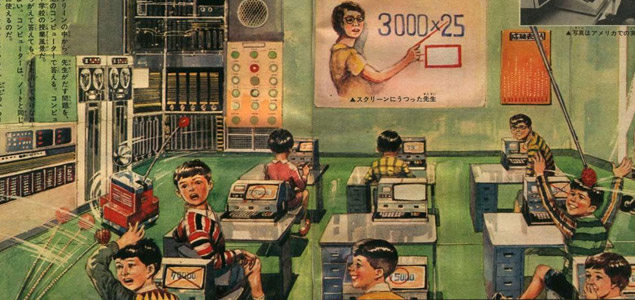
Shigeru Komatsuzaki, 1969. Computopia Magazine.
MOOCs (Massive Open Online Courses) are open-access courses that are taught over the Internet, free of charge. The nature of this new type of distance learning – which most prestigious international universities have started to offer in recent years – allows thousands of people around the world to access information, although MOOCs raise questions and have also been criticised. This article offers an overview of the brief history of MOOCs and explores their principal features, advantages and drawbacks. It also raises the possibility of offering these types of online education through cultural institutions.
A few years ago, it was easy to predict that the 2.0 digital revolution wave that was transforming the creative and cultural industries would soon hit education too. Today’s MOOC – Massive Open Online Courses – “fad” is simply the tip of an iceberg consisting of many initiatives that point the way towards a new type education, one that joins forces with technology in order to break down traditional academic barriers and timeframes, and is becoming more distributed than ever before. We now learn in many different contexts that go far beyond schools and universities and include libraries, museums and other cultural institutions as well as the inexhaustible digital domains.
We are used to thinking of education as something that is linear and takes place in a limited timeframe, in sacred temples, so there is bound to be criticism of the new “informal” forms of learning – which are no less real and powerful than “formal” types – that are emerging from the development of Internet technologies. Firstly, there was an initial resistance to virtual learning (“e-learning”) in general, even though the first MOOC projects and platforms deliberately echoed the familiar closed classroom environment. Soon – in parallel to the quantitative and qualitative increase of Internet resources that started to reproduced the universal library that Asimov already predicted – there began to be talk of the “googleisation” of education, of the superficiality of people being able to learn freely, employing Google or some other search engine or social and intellectual networks (Facebook, Twitter, blogs, etc…) on which people share their interests. But in spite of the criticism, these new types of teaching and learning continued to evolve, testing new ways systematising knowledge, adding value, and introducing pedagogic and professionalising elements to something that had already become an everyday reality anybody who does not want to be left out of the fluid society that we live in: personal language environments, Khan Academy, Open Education Resources (OER), edublogs, etc. The latest trend brings together elements from many different experiences into what we could group under the umbrella of “open social learning”.<0} And this is where MOOCs come in.
MOOCs are not precisely new. In 2008, groundbreaking projects started to take steps towards open learning, through blog-based workshops and similar initiatives that some people were already putting into practice. One of the first courses, Connectivism and Connective Knowledge, inspired the term MOOC and attracted over 2000 students from different countries. This course presented Connectivism as a new theory of learning in the digital context, developed by George Siemens and Stephen Downes.
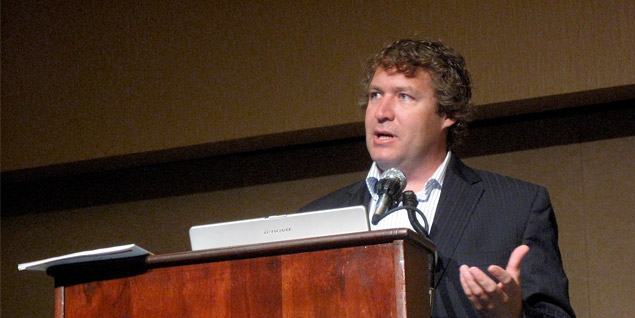
George Siemens Descibe Social Media. ED-MEDIA 2009.
Main features of MOOCs
- MOOCs can be run by any teacher, on any subject (they are often organised by teachers who have recently published a book, in order to publicise it). Because of their massive nature, however, they usually deal with subjects at an introductory level. They are often precisely that: an introduction to a particular subject that can capture the interest of future students of Masters projects or certified courses at the University or Business School that runs them.
- Even though students can choose to take courses freely or obtain a diploma signed only by the teacher, the opportunity to obtain the official qualification of the University that runs them usually remains open. This, and the possibility of taking certification exams, as explored by some centres such as MIT, is the basis for some of the business ideas to monetise some of these kinds of initiatives.
- Anybody with an interest in the subject in question can participate in a MOOC. The courses are not targeted at elites, and students only need a basic notion of 2.0 tools in order to see the course materials and participate. MOOCs also allow different levels of involvement, from simply reading, listening to or watching the course materials to active, non-hierarchical discussions with fellow students.
- The most common format used by MOOCs is a series of videos in which teachers explain the main ideas of the course. These videos are accompanied by different types of resources: html, pdfs, video-tutorials, presentations, synchronous virtual meetings at Google Hangouts or similar, etc.
- Problem solving and assessment – tasks that were traditionally carried out by teachers – tend to taken care of through a “peer to peer” process among fellow students. Either officially or through the course forums, participants often spontaneously suggest and use new resources to organise the content: Facebook groups, twitter hashtags, etc. are commonplace strategies for sharing interesting material related to the courses. MOOCs also often use self-assessment questionnaires, discussions and exercises based on different 2.0 tools (ideally on blogs or other spaces used by the participants).
- Although they were not part of the initial, connectivist MOOCs, the spread of the phenomenon has led to the creation of specific platforms to assist with access, enrolment, follow-up, etc. These are normally linked to the universities that organise them: Udacity at Stanford University, Coursera at Yale, Princeton, Michigan, Penn, UNAM, Monterrey Institute of Technology, etc., Edx at MIT (Massachusetts Institute of Technology), Miríada X at the National University of Distance Education (UNED) and King Juan Carlos University, in Spain etc. are a few examples. Google and other companies (Canvas, for example) have developed their own software for popular MOOCs.
Advantages and drawbacks
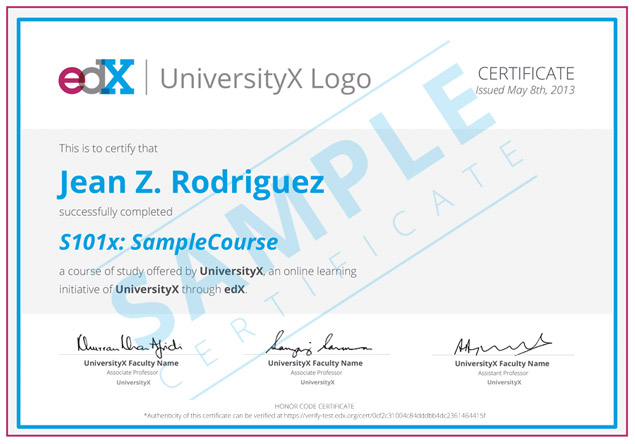
edX sample certificate.
We could say that the main advantages of MOOCs are the fact that they increase the value of what people can freely learn on the net. The principal added values include:
- The democratisation of access to education: As well as releasing content (as OERs and similar already did), MOOCs also open up the methodology, programming and pedagogic support, expanding access to the resources of a particular university to people from all walks of life and financial situations, from anywhere on the planet with an Internet connection.
- Digital literacy: Students who take the courses not only learn about the actual subject matter, they also improve their digital skills.
- Filtering: At a time of information overload due to the abundance of content on the Internet, MOOCs are a new form of what we call intermediaries or “content curators” (like certain websites, blogs, twitter accounts, and facebook pages of individuals from the cultural and educational sector). Value now comes from filtering, from the selection of relevant content in relation a particular subject, which is what MOOCs quite clearly do. This is why Bill Gates recently said that MOOCs don’t replace traditional education, but rather traditional handbooks, text books, and so on. I think that this is the most important argument in favour of organising initiatives such as MOOCs through cultural institutions in which these types of activities – content brokering, curating – are one of the fundamental social purposes.
- Big data and learning: One factor that certainly makes the massive scale of these types of courses meaningful is the abundance of the educational data (“learning analytics”) that they generate. In the Internet age – where some say that “data are the oil of the 21st century” and where learning is becoming an increasingly essential skill for 21st century citizens – there is clearly a great potential and statistical importance to monitoring and recording the learning processes of students. The idea is that Masters programmes, postgraduate studies, and future MOOCs could be improved by the data that is collected and analysed. Meanwhile, these types of courses also come under fire from some quarters. These are some of the main objections raised by critics of MOOCs:
- Lack of personalisation: The personal level, tutoring, has always been an essential part of high-quality education, including virtual education. By replacing teacher feedback with forum discussions and peer assessment, we decrease the value of one of the most essential elements of any kind of education: a teacher at the service of the particular needs of each individual student. This is the reasoning behind many of the arguments in defense of traditional education.
- Low cost, low quality education: While it makes sense to defend the democratisation of access to education and culture through MOOCs, it is also important to recognise that they can never replace the hours and intensity of a good university education. As such, they are sometimes accused of simply being a new type of “low cost” education for people who can’t pay to study at many leading universities. This leads us to another criticisms that often comes up in discussions around MOOCs: the high numbers who withdraw, and the low percentage of students who complete the courses.
Moocs and cultural institutions
I’ve now had the opportunity to impart and participate in several courses run by Coursera, Stanford (Venture Lab), UNIMOOC, etc. In some cases, it was extremely easy to obtain a certificate with the logotype of some major university, even with very few hours of study. In other cases, however, I had to invest a lot of hard work, ensuring successful learning, before I could obtain the diploma. As such, it is difficult to determine the quality standards of MOOCs from the certificates and diplomas issued to students who complete the course. It isn’t easy to draw general conclusions, but I agree with an idea that has often been expressed by researchers in this field: at present, we have overblown expectations of this type of learning. But then again, we are not talking about replacing schools or Universities, but about complementing or replacing introductory teaching. In their current form, MOOCs lack the necessary time and resources to explore subjects in depth, but they can give students an initial idea and stimulate their interest in going further.
This introductory aspect of critical filtering is the point at which MOOCs overlap with the traditional role of many cultural institutions. Setting up signposts, providing guidance for navigating through the infinite content of the net, is one of the primary – and increasingly essential – roles of cultural institutions. As in many other aspects of the digital era, it is important to be there, to actively participate. San Francisco Exploratorium offers two MOOCs and other institutions such as MoMA, Tate, the North Carolina Museum of Art and the American Museum of Natural History have already started to experiment with online courses and appear to be collaborating with the Coursera platform . What are we waiting for?
Recommended resources
Los museos se convierten en protagonistas de los MOOC (Observatorio MOOC 2013)
Laptop U. Has the future of college moved online? (Nathan Heller in the New Yorker, 2013)
Los Moocs: viables, inquietantes y consistentes (Lluís Anglada, Thinkepi 2013)

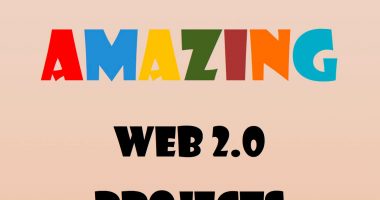
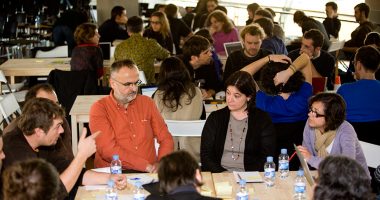


Marián | 15 September 2013
Ante mi inquietud permanente por el conocimiento me enrolé en uno de los cursos de Coursera la pasada primavera, impartido desde la UNAM. Toda la estructura de funcionamiento, los videos, el temario etc estaba realmente bien elaborado y resultaba muy útil el sistema de aprendizaje pero fallaba el contenido. Tuve la impresión de haber vuelto al colegio y a las dos semanas abandoné. La calidad de los contenidos era realmente deficiente, eso sí todo envuelto en una aureola de presentaciones multimedia etc, pero como indica el final del artículo, low cost, contenido básico que puedes encontrar en cualquier libro sobre el tema planteado. Una pena pues me interesaba mucho esta nueva forma de aprendizaje
Pilar J | 10 October 2013
Un buen artículo a propósito de los MOOC
http://controlmaszetablog.wordpress.com/2013/10/10/la-alternativa-se-llama-mooc/
Elisa | 14 March 2014
Hola.
Acabo de participar en un MOOC del INTEF.
Los contenidos pueden ser mejores o peores, pero la verdadera potencia de este tipo de cursos es la ingente cantidad de profesionales con similares intereses a ti con los que interactuas.
Personalmente, el material y los ponentes no estaban mal, pero he sacado muchísimo más partido a la colaboración con el resto de participantes en el curso, muchos de ellos de alto nivel.
Leave a comment